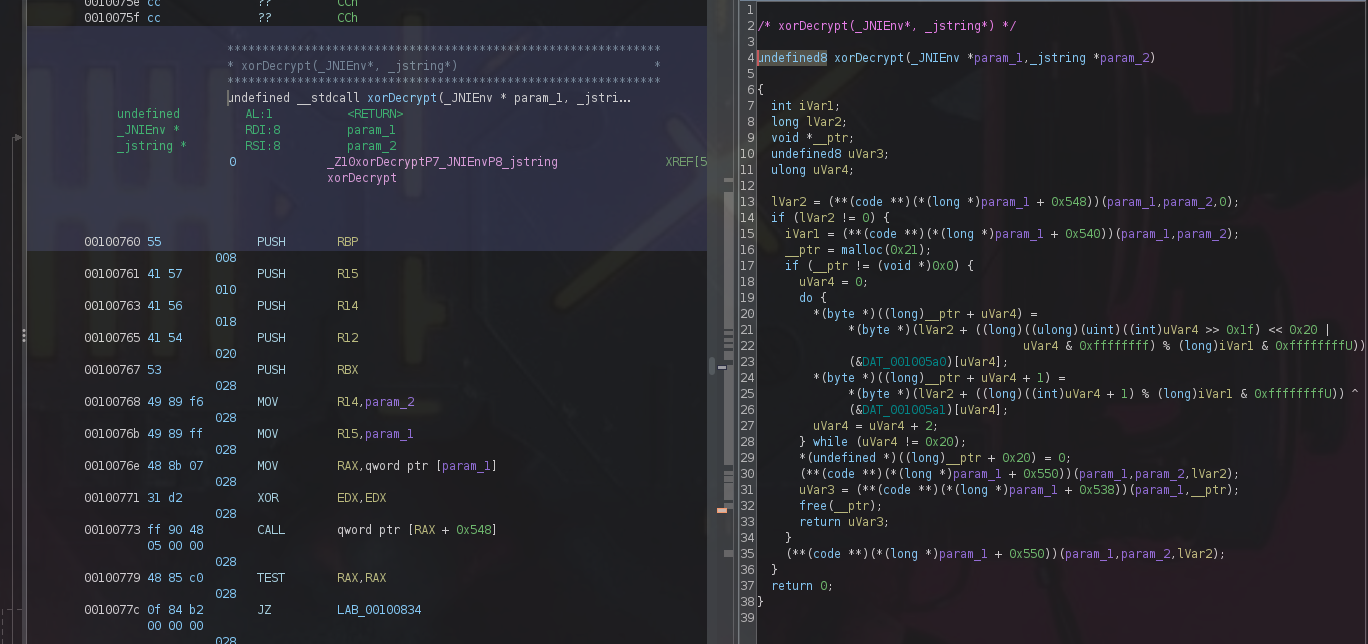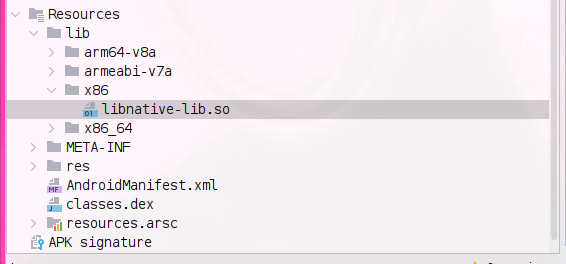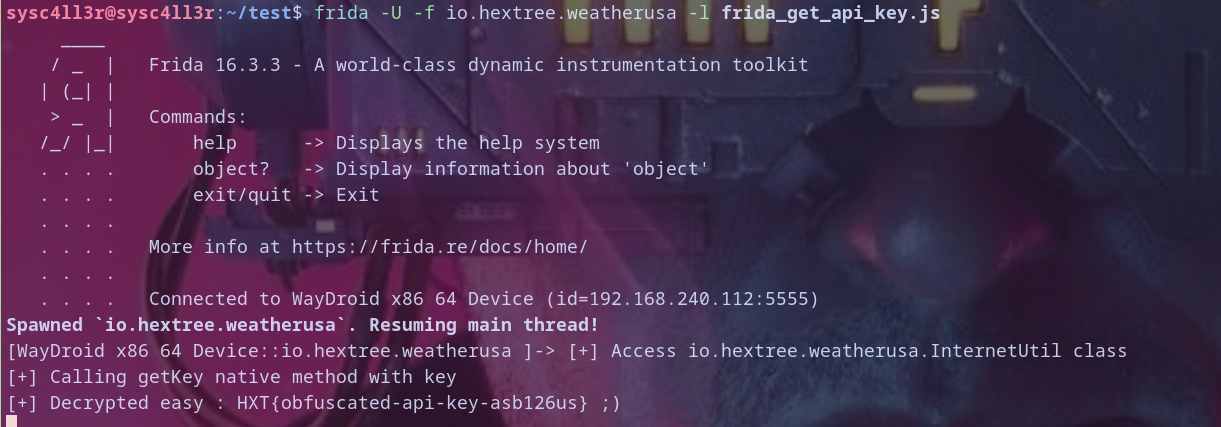Hextree Weather App - Defeating JNI Obfuscation
Today I explain my approach to solve the Defeating JNI Obfuscation challenge on hextree. The challenge can be described as the developer will not add a raw API key in the app, but he will add it encrypted and use JNI functions in a native library to decrypt the key to use it later.
The approach that LiveOverflow used is fine but requires writing the app from scratch and writing the same native library from scratch. My approach is analyze + runtime hooking by Frida. second appraoch by static analyzing. my approaches require less effort and less time .
First, we can download the APK file from This Link
Analyze
Open the downloaded APK in JADX to analyze it :
i found interest class called InternetUtil at app main package io.hextree.weatherusa so i started to check it u will find 2 methods used here public static String a(String,String) and private static native String getkey(String) as u know native methods in java is a bridge to call JNI native functions defined in c code.. if u don,t understand this don,t worry i will explain this in a later step in this writeup . u will find the a method load a native library native-lib System.loadLibrary do the following as pseudo code under the hood
System.loadLibrary(libraryName){
lib = path_to_appfiles/<cpu_arch>/"lib"+libraryName+".so"
dlopen(lib)
}
that mean the real name for library is libnative-lib.so as we notice this in JADX
u will find api key here used in header X-API-KEY but there is a call for getKey native method declared at the end of InternetUtil class as we see above u will find this line
1
httpURLConnection2.setRequestProperty("X-API-KEY", getKey("moiba1cybar8smart4sheriff4securi"));
which infer us that there is api key used but seems encrypted or not clear because there is a jni call getKey(api_key) which return String so we need to check getKey after extracting libnative-lib.so
extracting libnative-lib.so will can be done by just unzip it only from the apk because apk actully is a zip file but aligned by specific format 
now let,s fire ghidra and create ghidra project and then use decompiler (code explorer) and import library as file to anlayze
from functions we get i found interested function call Java_io_hextree_weatherusa_InternetUtil_getKey(_JNIEnv *param_1,undefined8 param_2,_jstring *param_3) native methods in java is used to call functions from c by this format : methodName() in c Java_com_package_classname_methodName() so native getKey() in java call Java_io_hextree_weatherusa_InternetUtil_getKey and take the return value from it
now notice Java_io_hextree_weatherusa_InternetUtil_getKey call xorDecrypt(param_1,param_3); so we need to analyze the decryption function xorDecrypt 
and now that,s the end of our analyze step
Pwn moment - Part 1 dynamic instrumentation solution
1.so we can use frida tool the dynamic instrumentation toolkit to solve this challenge easy, by calling this method getKey dynamically by frida
firda_get_api_key.js :
1
2
3
4
5
6
7
8
9
10
11
12
13
14
15
16
Java.perform(() => {
console.log("[+] Access io.hextree.weatherusa.InternetUtil class ")
var InternetUtil = Java.use("io.hextree.weatherusa.InternetUtil");
try {
InternetUtil.a.implmentation = function (arg1, arg2) {
console.log('[+] Calling Hooked InternetUtil.a method because it call System.loadLibrary("native-lib") which loadLibrary libnative-lib.so');
this.a(arg1,arg2);
};
InternetUtil.a("","")
console.log("[+] Calling getKey native method with key")
const decryptedKey = InternetUtil.getKey("moiba1cybar8smart4sheriff4securi");
console.log(`[+] Decrypted easy : ${decryptedKey} ;)`);
} catch (e) {
console.log("[!] Error: " + e);
}
});
let,s break it down
Java.usecan be used to access some class u wantJava.performused to perform or execute code- so we access
io.hextree.weatherusa.InternetUtilwhich is our interested in class and use frida to hook a method and overide its implementation to print this message and then call original a method - then we call
getKey(encrypted_key)method to decrypt it
install apk
1
adb install io.hextree.weatherusa_update1.apk
now let,s run it by :
1
frida -U -f io.hextree.weatherusa -l frida_get_api_key.js
We solve it ;) but wait we didn,t finished yet , in fact we have another solution that require better reverse engineering skills
Pwn Moment - Part 2 the static analyze solution
analyze xorDecrypt i will explain only hard parts
1
2
3
4
5
6
7
8
9
10
11
12
13
14
15
16
17
18
19
20
21
22
23
24
25
26
27
28
29
30
31
32
33
34
35
undefined8 xorDecrypt(_JNIEnv *param_1,_jstring *param_2)
{
int iVar1;
long lVar2;
void *__ptr;
undefined8 uVar3;
ulong uVar4;
lVar2 = (**(code **)(*(long *)param_1 + 0x548))(param_1,param_2,0);
if (lVar2 != 0) {
iVar1 = (**(code **)(*(long *)param_1 + 0x540))(param_1,param_2);
__ptr = malloc(0x21);
if (__ptr != (void *)0x0) {
uVar4 = 0;
do {
*(byte *)((long)__ptr + uVar4) =
*(byte *)(lVar2 + ((long)((ulong)(uint)((int)uVar4 >> 0x1f) << 0x20 |
uVar4 & 0xffffffff) % (long)iVar1 & 0xffffffffU)) ^
(&DAT_001005a0)[uVar4];
*(byte *)((long)__ptr + uVar4 + 1) =
*(byte *)(lVar2 + ((long)((int)uVar4 + 1) % (long)iVar1 & 0xffffffffU)) ^
(&DAT_001005a1)[uVar4];
uVar4 = uVar4 + 2;
} while (uVar4 != 0x20);
*(undefined *)((long)__ptr + 0x20) = 0;
(**(code **)(*(long *)param_1 + 0x550))(param_1,param_2,lVar2);
uVar3 = (**(code **)(*(long *)param_1 + 0x538))(param_1,__ptr);
free(__ptr);
return uVar3;
}
(**(code **)(*(long *)param_1 + 0x550))(param_1,param_2,lVar2);
}
return 0;
}
1.
1
lVar2 = (**(code **)(*(long *)param_1 + 0x548))(param_1,param_2,0);
calls a JNI function (offset 0x548 in param_1) which is _JNIENV as we see before in Java_io_hextree_weatherusa_InternetUtil_getKey to retrieve a pointer to the UTF-8 encoded representation of the string param2 , output will be lVar2 holding String as utf8 i hear u wonder how this calcuted :) , no problem i am here to help first as we know param_1 is _JNIENV structure right from offical oracle jvm documentation https://docs.oracle.com/en/java/javase/21/docs/specs/jni/functions.html we will do the following equation function_offset/machine_pointer_size = function index in _JNIENV u can search by this index it in oracle jni docs by above link machine_pointer_size here will be 8 for x86_64 cause i use this cpu arch so param_1+0x548=_JNIENV+0x548 this converted to function pointer as we see by **(code **)(*(long *) so 0x548/8 = 169 if we searched by 169 in JNI Strcture  we will find it mapped to
we will find it mapped to GetStringUTFChars if we search by 169 - when this function pointer called it,s convert string data at pointer to utf8 string and lVar2 will hold result if (lVar2 != 0) mean return if converting failed , lVar2 will be NULL in this case : return if IVar2 = 0x00000000000
1
iVar1 = (**(code **)(*(long *)param_1 + 0x540))(param_1,param_2);
0x540/8 = 168refer toGetStringUTFLengthcalc length forutf8stringiVar1store string atiVar2length 3.__ptr = malloc(0x21);allocate 33 byte for pointer ,if (__ptr != (void *)0x0)means continue if pointer valid 4.1 2 3 4 5 6 7 8 9 10 11
uVar4 = 0; do { *(byte *)((long)__ptr + uVar4) = *(byte *)(lVar2 + ((long)((ulong)(uint)((int)uVar4 >> 0x1f) << 0x20 | uVar4 & 0xffffffff) % (long)iVar1 & 0xffffffffU)) ^ (&DAT_001005a0)[uVar4]; *(byte *)((long)__ptr + uVar4 + 1) = *(byte *)(lVar2 + ((long)((int)uVar4 + 1) % (long)iVar1 & 0xffffffffU)) ^ (&DAT_001005a1)[uVar4]; uVar4 = uVar4 + 2; } while (uVar4 != 0x20);
this is a loop in this loop uVar4=0 and it increased by 2 each cycle and this loop should stop when uVar2 = 32 notice length of our encrypted api key = 32
len("moiba1cybar8smart4sheriff4securi")so this loop
*(byte *)((long)__ptr + uVar4) mean there is a byte will stored at _ptr[uVar4] the byte is result of lVar2[uVar4 % uVar1] ^ DAT_001005a0[uVar4 %uVar1] DAT_001005a0 if we look at .rodata segment we will find array of bytes represent key
1
2
3
[0x25,0x37, 0x3D, 0x19, 0x0E, 0x53, 0x05, 0x0C, 0x11, 0x02, 0x13, 0x4C, 0x16, 0x09,
0x4C, 0x13, 0x04, 0x5D, 0x5E, 0x03, 0x00, 0x0B, 0x44, 0x07, 0x15, 0x56, 0x42, 0x57,
0x55, 0x00, 0x01, 0x14]
and do the same with next byte mean another xor operation finally means encryptedString[int(counter % length )] ^ key[int(counter % length )] any operation like & 0xffffffff , >> 0x1f) << 0x20 , & 0xffffffffU to handle just sign of uVar4 ,iVar1 .do u see how it now more clear ? :D
*(undefined *)((long)__ptr + 0x20) = 0;is final step to add null terminator byte00to the end of stirng1 2 3 4
(**(code **)(*(long *)param_1 + 0x550))(param_1,param_2,lVar2); uVar3 = (**(code **)(*(long *)param_1 + 0x538))(param_1,__ptr); free(__ptr); return uVar3;
_JNIENV+0x550 = function offset 170 (u now know how this calculated) at _JNIENV structure which is ReleaseStringUTFChars free the encrypted utf8 String memory
_JNIENV+0x538 = function offset 167 at _JNIENV structure which is NewStringUTF generate utf8 string from decrypted string at __ptr and store the new pointer for it at uVar3
then free decrypted ascii data at __ptr cause we have new utf8 verstion of decrypt text at uVar3 then return this utf8 pointer as jstring
let,s simulate the operation with python to decrypt key
1
2
3
4
5
6
7
8
9
10
11
12
13
14
15
16
17
18
key_bytes = [0x25,
0x37, 0x3D, 0x19, 0x0E, 0x53, 0x05, 0x0C, 0x11, 0x02, 0x13, 0x4C, 0x16, 0x09,
0x4C, 0x13, 0x04, 0x5D, 0x5E, 0x03, 0x00, 0x0B, 0x44, 0x07, 0x15, 0x56, 0x42, 0x57,
0x55, 0x00, 0x01, 0x14
]
def xor_decrypt(input_bytes):
string_length = len(input_bytes)
decrypted_bytes = bytearray()
for i in range(32):
decrypted_byte = input_bytes[i % string_length] ^ key_bytes[i]
decrypted_bytes.append(decrypted_byte)
return decrypted_bytes.decode('utf-8', errors='ignore')
encrypted_data = bytearray("moiba1cybar8smart4sheriff4securi", 'utf-8')
decrypted = xor_decrypt(encrypted_data)
print("[+] Decrypted key:", decrypted)
and when running it we found the key again :)
thx for reading , see u later in next writeup <3





